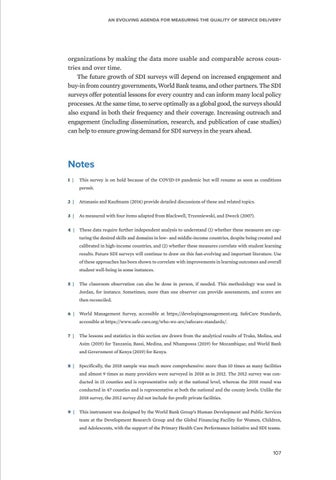An evolving agenda for measuring the quality of service delivery
organizations by making the data more usable and comparable across countries and over time. The future growth of SDI surveys will depend on increased engagement and buy-in from country governments, World Bank teams, and other partners. The SDI surveys offer potential lessons for every country and can inform many local policy processes. At the same time, to serve optimally as a global good, the surveys should also expand in both their frequency and their coverage. Increasing outreach and engagement (including dissemination, research, and publication of case studies) can help to ensure growing demand for SDI surveys in the years ahead.
Notes 1 | This survey is on hold because of the COVID-19 pandemic but will resume as soon as conditions permit. 2 | Attanasio and Kaufmann (2014) provide detailed discussions of these and related topics. 3 | As measured with four items adapted from Blackwell, Trzesniewski, and Dweck (2007). 4 | These data require further independent analysis to understand (1) whether these measures are capturing the desired skills and domains in low- and middle-income countries, despite being created and calibrated in high-income countries, and (2) whether these measures correlate with student learning results. Future SDI surveys will continue to draw on this fast-evolving and important literature. Use of these approaches has been shown to correlate with improvements in learning outcomes and overall student well-being in some instances. 5 | The classroom observation can also be done in person, if needed. This methodology was used in Jordan, for instance. Sometimes, more than one observer can provide assessments, and scores are then reconciled. 6 | World Management Survey, accessible at https://developingmanagement.org. SafeCare Standards, accessible at https://www.safe-care.org/who-we-are/safecare-standards/. 7 | The lessons and statistics in this section are drawn from the analytical results of Trako, Molina, and Asim (2019) for Tanzania; Bassi, Medina, and Nhampossa (2019) for Mozambique; and World Bank and Government of Kenya (2019) for Kenya. 8 | Specifically, the 2018 sample was much more comprehensive: more than 10 times as many facilities and almost 9 times as many providers were surveyed in 2018 as in 2012. The 2012 survey was conducted in 15 counties and is representative only at the national level, whereas the 2018 round was conducted in 47 counties and is representative at both the national and the county levels. Unlike the 2018 survey, the 2012 survey did not include for-profit private facilities. 9 | This instrument was designed by the World Bank Group’s Human Development and Public Services team at the Development Research Group and the Global Financing Facility for Women, Children, and Adolescents, with the support of the Primary Health Care Performance Initiative and SDI teams.
107


